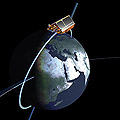|
Coverage: The
validation experiment for the Coastal Ocean will take place over the
North-West European Shelf Region – where CPP data are available and in
situ measurements have been identified
Time
Period: To be defined
Cryosat-2
Data Products Used:ESA SAR Baseline A L1b and CPP SAR
L1b Products
Method: Optimal SAR Re-tracking Methodology and Validation over Open Ocean
In
this task, we propose to apply the SAMOSA SAR waveform model(s) to CPP
products to compare with previous results obtained with IPF SAR L1B
waveforms.
The SAR retracking methodology will be developed
and optimized using internal consistency tests and comparisons against
independent data from other satellites (e.g. Jason-2) and in situ
measurements (e.g. offshore wave buoys).
Optimal SAR Re-tracking Methodology and Validation over Coastal Ocean
We
examine the quality of the Cryosat-2 SAR waveforms and of retracked
geophysical values within 10 kilometres of land, to determine the
degree of contamination by land for different track/coastline
orientations compared to conventional satellite altimeters. Both IPF
SAR L1B (baseline A) and CPP products retracked with the SAMOSA and the
CNES model will be examined. Based on this, we determine what could be
undertaken to further improve the SAR mode data close to land. Second,
we take advantage of the extensive in situ measurements of waves and
sea level from inshore buoys and tide gauges along the south coast of
the UK to perform a more in depth validation of the Cryosat-2 SAR data.
Retracked SSH will be corrected for geophysical effects (e.g. wet
tropospheric delay) using the corrections in the ESA products and new
corrections developed within CP4O. The proximity of in situ wave and
sea level measurements will afford a first look at the performance of
C2 SAR against tide gauges in different sea states. Particular
attention will be give to finding occurrences of swell from different
directions to try to distinguish any possible impact on SAR waveforms
and retrieved range.
<--
Data
Home
|

